|
An
extensive article introducing non-modelers to aircraft modeling appeared
in the Annual Edition of the 1962 American Modeler magazine. 15 pages were
devoted to describing just about every aspect of model building and flying
- free flight gas and rubber; control line stunt, combat, scale, and speed;
helicopters and ornithopters; indoor gliders, stick and tissue, and microfilm;
even some early radio control. In order to keep page length here
reasonable (because of all the images), the article is broken into a few
pages. Pages: |
10 & 11 |
12|
13
|
14 |
15
|16
|
17 |
18
|
19 |
20
|
21 |
22
|23
|
24 | For Non-Modelers: All About Air Modeling
20 Easy Ways to Go Crazy! <previous> <next>
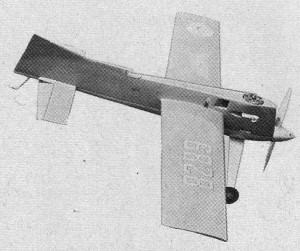
Proto speedster is marked by its fixed landing gear and dummy cockpit.
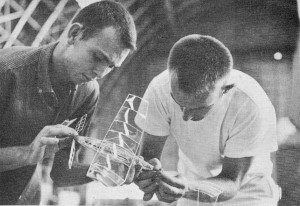
Tense moment comes during indoor event when fully-wound rubber motor
is at-tached to removable tail boom. Fragile microfilm-covered, almost
weightless transparent planes can be damaged by a healthy sneeze.
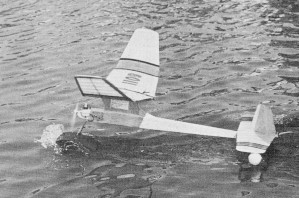
The "ROW" event is for float-equipped free flight gas planes which are
supposed to "rise-off-water" under their own power. Georgia entry (below)
utilizes ping pong balls.
All the tricks of adjusting and trimming learned from glider and rubber
jobs are employed in getting good performance out of a high powered free
flight model. Climb in a steep wide open spiral and circling glide after
power cuts is the usual flight pattern. Controlling the power in the climb
and still retaining glide trim really brings out a modeler's skill at proper
adjustment, or lack of it. CONTROL LINE - The late
Jim Walker really shook up model flying in 1940 with his early U-Control
model flight demonstrations. Like most great inventions the U-Control idea
was a simple one. Instead of chasing a soaring model cross-country... why
not stand in one spot and let the model fly in a circle around you? Few
innovations in model flying gained such instant enthusiastic acceptance
by modelers everywhere. The effervescent Jim exhibited his first U-control
models at the 1940 Nationals. That first performance-packed "Fireball" puts
a lot of today's control liners to shame, Powered with an ignition O&R
23 engine, the 3 foot span all-balsa Fireball was capable of speeds up to
75 mph, could do loops, fly inverted and land like a feather, With Its lifting
(not symmetrical airfoil) it could be hand-launched with the U-Reely control
handle and zero line length, then reeled out to fly in 100 ft. radius circles.
Jim Walker and his Fireball set the pattern for practically all
of the many phases of control-line flying as we know it today. Clipped wing
Fireballs with big engines started speed flying. Lightened glow engine powered
Fireballs could fly the stunt pattern - after all it's just a series of
loops linked together in various combinations. Glider pickups, balloon busting,
tail stands, flying three models in one circle... all these stunts first
done by Jim have found their way into control line flying in one form or
another. See today's Rat Racing, Combat and Precision Acrobatics.
If the object of free flight flying is endurance (by pre-flight adjustment
and design) the object of control line flying is the DIRECT CONTROL of the
performance of the model during its flight by the flyer, The major factor
in control line's popularity is the fact that flying can be done in a relatively
small space as compared with free flight. There is no need for a wide expanse
of open fields. Small 1/2A powered ships can be flown in a large backyard,
The larger types flown on up to 70 ft. lines require at least the width
of a football field for safety clearance around the circle. So instead of
flying in the wide open spaces, modelers can fly control line closer to
home, This unfortunately presents an entirely different problem - noise!
Model flying and its attendant engine sounds close to residential areas
are cause for complaints by the neighbors, so even control line flying is
best done away out from the center of some towns.
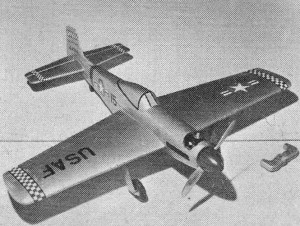
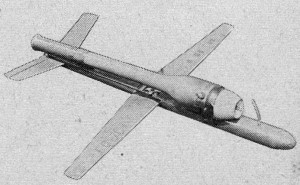
Foam plastic ready-to-fly control line scaler, P-51
Jet powered speed entry uses miniature pulse jet
made by Sterling Models. Powered by .15-size
engine (Dyna-Jet) for control line competition.
glow plug engine.
<previous> <next>
Posted December 25, 2010
|



